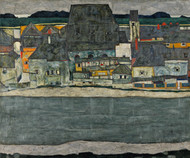Egon Schiele
Published by Therese Myles on 19th Oct 2019
Egon Schiele was born in Austria in the year of 1890. He is considered to be an integral part of the Figurative art movement and also later in his life the beginnings of the Expressionism art movement. Schiele is one of the most famous and influential painters of the twentieth century.
He was born the son of a railway master and Czech woman, it what was then called Lower Austria. Due to his father's profession the young Egon spent a great deal of time around trains, causing him to become fascinated with them. This, as well as a natural affinity for drawing and art, led Egon to obsessively draw pictures and sketches of trains, tacks, and railways as a child.
He moved to the city of Klosterneuburg in about 1901 to attend school. At school Egon rarely socialized, but continued his pursuit of art, becoming quite adept at drawing by his teen age years. His family life was very troubled, his father disagreed with Egon's commitment to pursuing art and there is some evidence to suggest that he had been having an incestuous affair with his younger sister, so his family believed at any rate.
In 1906 Egon's father died of syphillis and he was sent to live with his slightly more tolerant uncle, who allowed him to have an art tutor, a man by the name of Ludwig Karl Strauch. Egon's skills were already beginning to surpass those of his tutor however, and later that year he applied and was accepted into the Kunstgewerbeschule School of Arts and Crafts, located in Austria's capital, Vienna. After less than a year of study at the School of Arts and Crafts, Egon's remaining family forced him to go to the traditionalist school Akademie der Bildenden Künste, also located within the city of Vienna.
Egon spent three years at the Akademie der Bildenden Künste, being taught by the ultra conservative painter, Christian Griepenkerl. He hated the subject matter and especially disliked the traditionalist views of his professor, so by 1909 he dropped out and left the school for good.
Egon Schiele had always been fascinated with the works of his older contemporary artist, the Austrian painter and leader of the Vienna Secessionist art movement, Gustav Klimt. After leaving school, Egon decided to seek out Klimt, whom he found without much trouble. Klimt recognized Schiele's budding talent and mentored him, as well as helped to support him financially by buying his early drawings and paintings. It was with Gustav Klimt's help that Schiele was able to mount his first ever art exhibition, back in the city he had first attended school in, Klosterneuburg. Soon after he founded the Neukunstgruppe, which translates to New Art Group in English, which was a group of young non traditionalist artists.
In 1909, the young, nineteen year old Egon Schiele was invited to the Vienna Kunstschau to exhibit some of his work. His personal style was very bold and liberal, and his works often addressed erotic themes, as well as unashamed depictions of the human body. This drew some criticism from the public as many found Schiele's art to be too explicit or sexual at that time.
Soon Schiele and his art group were touring through Europe, Schiele's works having gained a great deal of fame and notoriety for their controversial subject matter. He conducted his first few solo art showings in this time period as well, first in Munich, Germany, then in Paris France.
Schiele got married and moved with his wife to a town called Neulengbach, where he soon earned himself a bad reputation and even ended up being thrown in jail for trying to seduce an under age girl in the town. He spent about a month in jail before being released.
With Europe now being consumed in the fires of World War One, Schiele found it harder and harder to avoid the draft and was eventually drafted and sent to the city of Prague, where the War and its horrors began to have more of an influence upon his art work. He was allowed to continue to paint during his military service, and his reputation grew during the war.
In 1917 Egon Schiele returned to Vienna to focus on his art and he displayed many of his greatest pieces during the following year, achieving the height of his fame in 1918. This was not to last however, as the world wide Spanish Flu pandemic hit Austria. Egon Schiele succumbed to the flu in a few days and died at the age of 28, leaving behind a surprisingly large legacy of work.
View Egon Schiele Gallery

